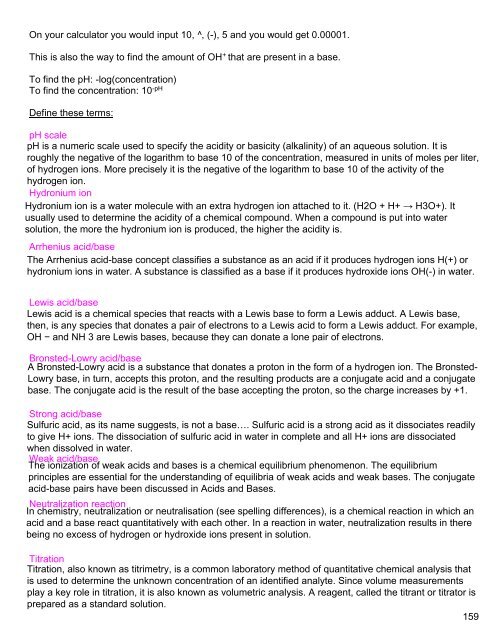You also want an ePaper? Increase the reach of your titles
YUMPU automatically turns print PDFs into web optimized ePapers that Google loves.
On your calculator you would input 10, ^, (-), 5 and you would get 0.00001.<br />
This is also the way to find the amount of OH + that are present in a base.<br />
To find the pH: -log(concentration)<br />
To find the concentration: 10 -pH<br />
Define these terms:<br />
pH scale<br />
pH is a numeric scale used to specify the acidity or basicity (alkalinity) of an aqueous solution. It is<br />
roughly the negative of the logarithm to base 10 of the concentration, measured in units of moles per liter,<br />
of hydrogen ions. More precisely it is the negative of the logarithm to base 10 of the activity of the<br />
hydrogen ion.<br />
Hydronium ion<br />
Hydronium ion is a water molecule with an extra hydrogen ion attached to it. (H2O + H+ → H3O+). It<br />
usually used to determine the acidity of a chemical compound. When a compound is put into water<br />
solution, the more the hydronium ion is produced, the higher the acidity is.<br />
Arrhenius acid/base<br />
The Arrhenius acid-base concept classifies a substance as an acid if it produces hydrogen ions H(+) or<br />
hydronium ions in water. A substance is classified as a base if it produces hydroxide ions OH(-) in water.<br />
Lewis acid/base<br />
Lewis acid is a chemical species that reacts with a Lewis base to form a Lewis adduct. A Lewis base,<br />
then, is any species that donates a pair of electrons to a Lewis acid to form a Lewis adduct. For example,<br />
OH − and NH 3 are Lewis bases, because they can donate a lone pair of electrons.<br />
Bronsted-Lowry acid/base<br />
A Bronsted-Lowry acid is a substance that donates a proton in the form of a hydrogen ion. The Bronsted-<br />
Lowry base, in turn, accepts this proton, and the resulting products are a conjugate acid and a conjugate<br />
base. The conjugate acid is the result of the base accepting the proton, so the charge increases by +1.<br />
Strong acid/base<br />
Sulfuric acid, as its name suggests, is not a base…. Sulfuric acid is a strong acid as it dissociates readily<br />
to give H+ ions. The dissociation of sulfuric acid in water in complete and all H+ ions are dissociated<br />
when dissolved in water.<br />
Weak acid/base<br />
The ionization of weak acids and bases is a chemical equilibrium phenomenon. The equilibrium<br />
principles are essential for the understanding of equilibria of weak acids and weak bases. The conjugate<br />
acid-base pairs have been discussed in Acids and Bases.<br />
Neutralization reaction<br />
In chemistry, neutralization or neutralisation (see spelling differences), is a chemical reaction in which an<br />
acid and a base react quantitatively with each other. In a reaction in water, neutralization results in there<br />
being no excess of hydrogen or hydroxide ions present in solution.<br />
Titration<br />
Titration, also known as titrimetry, is a common laboratory method of quantitative chemical analysis that<br />
is used to determine the unknown concentration of an identified analyte. Since volume measurements<br />
play a key role in titration, it is also known as volumetric analysis. A reagent, called the titrant or titrator is<br />
prepared as a standard solution.<br />
159



